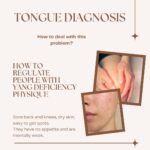TCM (Traditional Chinese Medicine) tongue diagnosis is a crucial component of the TCM inspection method. It holds that the tongue is not only a part of the digestive system but also a direct reflection of the functional status of internal organs, qi, blood, and body fluids. Since the tongue’s shape is determined by muscle—an aspect governed by the spleen—observing its form can offer insights into the health of the spleen and, by extension, the entire body. This article, from the perspective of TCM tongue diagnosis, provides a detailed explanation of the various tongue shapes and the corresponding internal pathological changes, serving as a valuable reference for clinical diagnosis and syndrome differentiation.
一. Enlarged Tongue (TCM Tongue Diagnosis Observation)
An enlarged tongue is one that appears noticeably wider than normal; when extended, it fills the oral cavity. TCM tongue diagnosis considers this phenomenon primarily as a result of the accumulation of phlegm, dampness, or heat toxins. In examining such a tongue, attention should also be paid to its color, coating, and any red spots present on the surface.
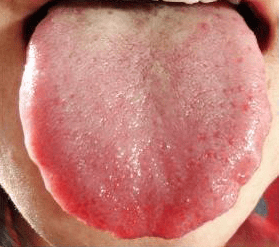
- Enlarged Light Red Tongue — Tongue appears large, light red, with a yellow greasy coating
- Description: TCM tongue diagnosis suggests that an enlarged light red tongue is often due to damp-heat in the spleen and stomach, with phlegm-damp competing, leading to the upward overflow of turbid phlegm and fluids.
- Tongue Features: A noticeably enlarged tongue with a yellow greasy coating.
- Associated Pathogenesis: Indicates the presence of damp turbidity and phlegm accumulation, commonly seen in chronic digestive and respiratory diseases.
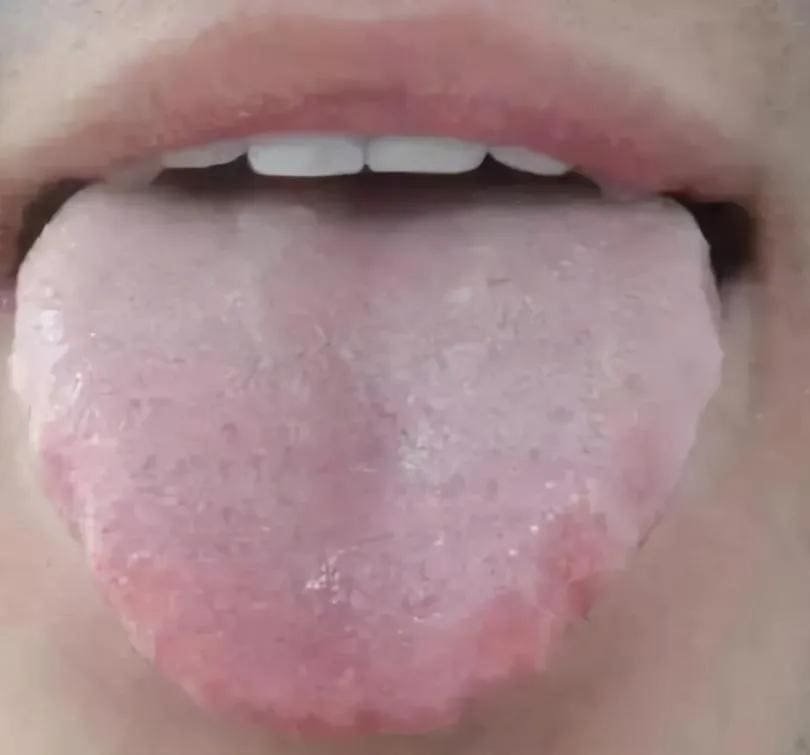
- Enlarged Tender White Tongue — Tongue appears large, light white, with a white slippery coating
- Description: According to TCM tongue diagnosis, this tongue type is frequently associated with spleen-kidney yang deficiency, where qi fails to transform body fluids, resulting in an accumulation of dampness.
- Tongue Features: An enlarged, tender, light white tongue with a white slippery coating.
- Associated Pathogenesis: Suggests spleen-stomach yang deficiency and internal dampness, often found in cases such as anemia, chronic gastritis, and kidney disorders.
二. Thin Tongue (TCM Tongue Diagnosis Observation)
A thin tongue is characterized by its small, slender, and delicate appearance, usually due to qi and blood deficiency as well as insufficient body fluids. Modern medicine also correlates a thin tongue with malnutrition.

-
Thin Red Tongue — Tongue appears thin, red, and dry
- Description: TCM tongue diagnosis points out that a thin tongue indicates inadequate nutrition and hydration, while the reddish hue suggests internal heat or inflammation. Prolonged heat can consume body fluids and deplete nourishment.
- Tongue Features: A thin, shriveled tongue that is much redder than normal.
- Associated Pathogenesis: Reflects yin deficiency with hyperactive fire and insufficient body fluids, often seen in the convalescent stage of febrile diseases or in chronic wasting conditions.
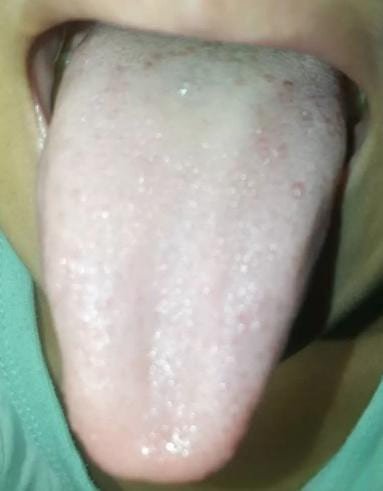
-
Thin Pale White Tongue — Tongue appears thin and pale white
- Description: This tongue type is mainly associated with poor overall nutritional supply, reflecting weakened warming and nourishing functions of qi and blood.
- Tongue Features: A tongue that is thinner and more narrow than normal, with a pale white color and lacking vitality.
- Associated Pathogenesis: Indicates qi and blood deficiency with malnutrition, commonly observed in chronic anemia.
三. Aged Tongue (TCM Tongue Diagnosis Observation)
An aged tongue is characterized by a thick, rough texture with dry and coarse surface lines resembling the skin of the elderly. TCM tongue diagnosis asserts that regardless of the tongue coating color, an aged tongue is indicative of excess or heat syndromes.
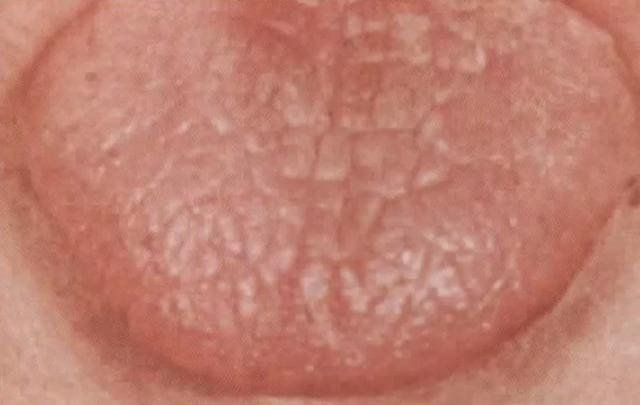
-
Aged Tongue — Tongue appears aged, with abnormal color
- Description: When pathogenic factors attack, the body’s defensive mechanisms activate various systems (immunity, circulation, metabolism) to combat the illness. The tongue then appears aged, dry, and cracked. Modern medicine links this to decreased parasympathetic tone and increased sympathetic activity, which reduces saliva secretion.
- Tongue Features: The tongue may exhibit colors such as bluish, yellow, crimson, white, or black depending on the affected organs, yet overall it appears aged.
- Associated Pathogenesis: Suggests an excessive presence of heat pathogens and a syndrome of excess, with the specific tongue color helping to differentiate which internal organ is predominantly affected.
四. Delicate Tongue (TCM Tongue Diagnosis Observation)
A delicate tongue is one with a fine, smooth texture and a pale color; it appears plump and delicate, sometimes even translucent. TCM tongue diagnosis links this presentation mainly with cold syndromes due to qi and blood deficiency and weakened yang, which result in insufficient transformation of fluids. This type is commonly seen in the later stages of chronic illnesses.
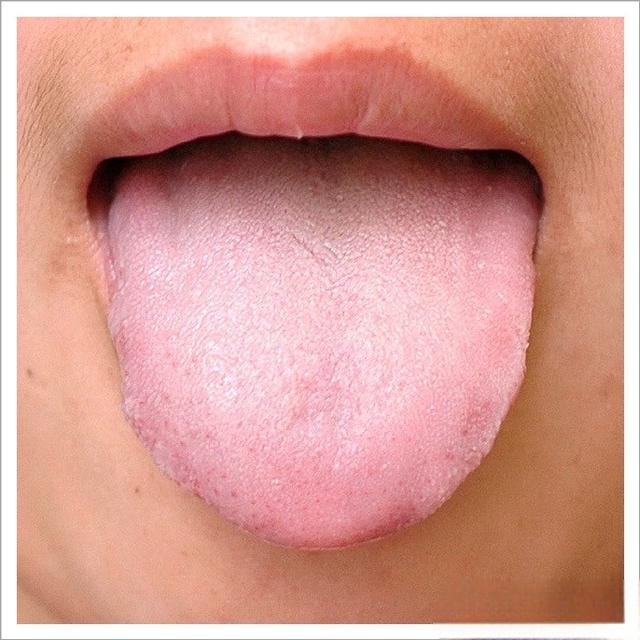
-
Delicate Pale White Tongue — Tongue appears delicate, light white
- Description: Insufficient yang leads to a heavy accumulation of cold, resulting in a pale white tongue that is often enshrouded by dampness.
- Tongue Features: A delicate tongue that is pale white and often displays tooth marks along the sides.
- Associated Pathogenesis: Indicates yang deficiency and warrants attention to possible internal cold-damp accumulation.
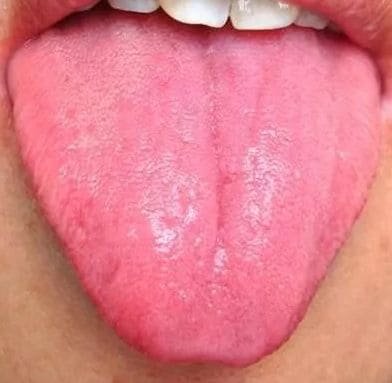
-
Plump Mirror-Like Tongue — Tongue appears plump and delicate with a mirror-like smooth surface, lacking any coating
- Description: A slightly reddish tone suggests the presence of internal heat, but the tender, mirror-like appearance points to a deficiency of the spleen’s qi that fails to nourish the tongue adequately.
- Tongue Features: A plump, delicate tongue with a smooth, uncoated surface and a slight reddish tint.
- Associated Pathogenesis: Reflects both qi and yin deficiency and spleen weakness, requiring appropriate syndrome differentiation.
五. Punctate/Stippled Tongue (TCM Tongue Diagnosis Observation)
A punctate tongue displays red dots or even small, raised spicules on the surface. TCM tongue diagnosis considers these signs as indicative of severe heat that has accumulated in the gastrointestinal tract or high fever that has excessively consumed body fluids.

There may be a problem with the English translation or grammar here, the Chinese name is: (点刺舌)
-
Punctate Tongue with Yellow, Dry Coating
- Description: The presence of red dots or spicule-like projections, combined with a yellow, dry coating, often signals intense internal heat and may be associated with distension and pain around the navel due to heat accumulation in the large intestine.
- Tongue Features: Red dots or spicule-like elevations with a yellow, dry coating.
- Associated Pathogenesis: Indicates conditions such as damp-heat febrile illnesses or high fever with constipation.
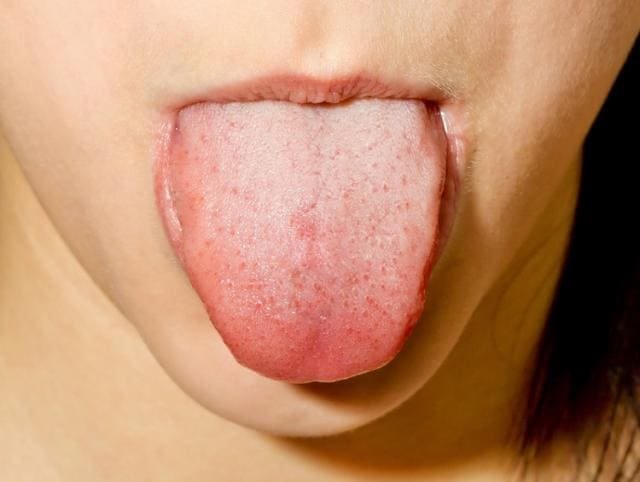
There may be a problem with the English translation or grammar here, the Chinese name is: (点刺舌)
-
Punctate Tongue in Different Regions
- Description: TCM tongue diagnosis emphasizes that the location of these punctate changes can reflect the involvement of different internal organs:
- Tip of the tongue: Suggests heart fire hyperactivity, potentially related to conditions like neurasthenia or insomnia.
- Middle of the tongue: Points to gastric and intestinal heat, warranting caution regarding gastrointestinal disorders.
- Lateral edges of the tongue: Often indicate liver and gallbladder fire, which can be associated with emotional issues such as depression or anxiety.
六. Tongue with Tooth Marks (TCM Tongue Diagnosis Observation)
A tongue with tooth marks presents indentations along its lateral margins. In TCM tongue diagnosis, this sign often accompanies an enlarged, delicate tongue and is primarily indicative of spleen qi deficiency, resulting in dampness and phlegm accumulation.
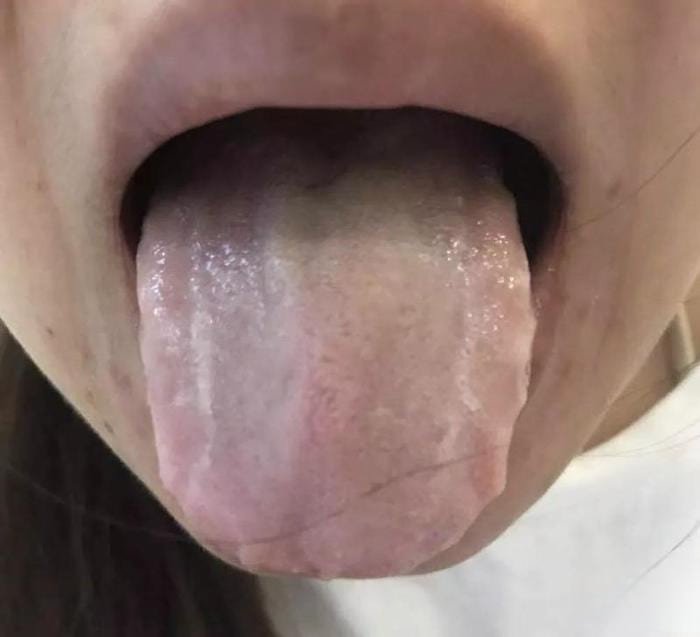
The Chinese name is: (齿痕舌), but in English grammar it is called: (scalloped tongue).
-
Enlarged Tongue with Tooth Marks — Tongue appears large with clear tooth marks along the edges
- Description: A deficiency in yang causes dampness to accumulate, making the tongue swollen and vulnerable to indentation by the teeth.
- Tongue Features: Noticeable tooth marks along the edge, with an enlarged tongue, a white coating, and a moist, slippery surface.
- Associated Pathogenesis: Reflects spleen and kidney yang deficiency with damp-phlegm retention, often seen in chronic nephritis or gastritis.
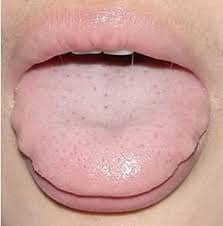
The Chinese name is: (齿痕舌), but in English grammar it is called: (scalloped tongue).
-
Pale Tongue with Tooth Marks — Tongue appears pale with tooth marks
- Description: Spleen deficiency leads to insufficient production of qi and blood, resulting in a pale tongue accompanied by tooth marks.
- Tongue Features: A tongue that is not enlarged but shows tooth marks along its edges, with a pale, bloodless appearance.
- Associated Pathogenesis: Indicates qi and blood deficiency, commonly observed in chronic illnesses, excessive mental strain, malabsorption, or anemia.
七. Smooth (Mirror-Like) Tongue (TCM Tongue Diagnosis Observation)
A smooth tongue, also known as a mirror-like tongue, has a clean, glossy surface free from any coating. TCM tongue diagnosis links this appearance primarily to a depletion of stomach yin or damage to stomach qi, leading to a lack of sufficient body fluids to moisten the tongue.
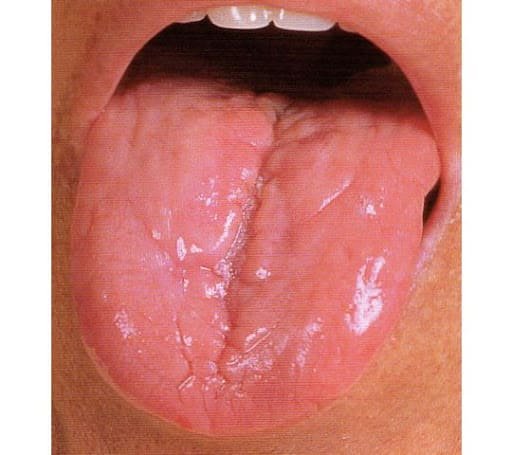
-
Smooth Crimson Tongue — Tongue appears smooth, crimson, without any coating
- Description: A smooth, crimson tongue without a coating indicates an abundance of internal heat that has severely damaged yin, resulting in a significant loss of fluids.
- Tongue Features: A glossy, uncoated surface with a crimson hue.
- Associated Pathogenesis: Reflects a condition of depleted fluids with overwhelming heat, often involving stomach and kidney yin deficiency.

-
Smooth Pale White Tongue — Tongue appears smooth, pale white, and without any coating
- Description: In the absence of stomach qi rising and with concurrent damage to the spleen and stomach resulting in qi and blood deficiency, the tongue takes on a pale white appearance.
- Tongue Features: A smooth, uncoated surface that is pale white and lacking in vitality.
- Associated Pathogenesis: Indicates stomach injury with qi and blood deficiency.
八. Fissured Tongue (TCM Tongue Diagnosis Observation)
A fissured tongue is one that displays uneven, irregular grooves of varying depths across its surface. TCM tongue diagnosis views fissures as a manifestation of yin deficiency with heat excess and body fluid loss; the number and depth of the fissures can correlate with the severity of the condition. Horizontal fissures, in particular, suggest a longstanding deficiency of body fluids.
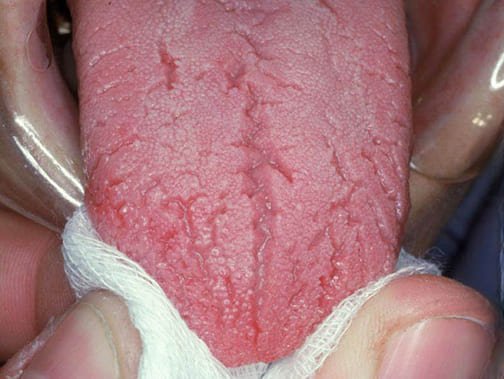
-
Fissured Red Tongue — Tongue shows fissures and appears red
- Description: A red tongue with fissures suggests internal heat, such as excessive stomach fire or heart fire. Fissures in the middle imply latent fire in the spleen and stomach, while fissures at the tip are more associated with hyperactive heart fire.
- Tongue Features: A red tongue with yellow coating and fissures; the tip may be a deep crimson with noticeable cracks.
- Associated Pathogenesis: Fissures in the middle can be accompanied by halitosis, mouth ulcers, or swollen gums, whereas fissures at the tip may be related to tongue tip pain, insomnia with vivid dreams, or aphthous ulcers.
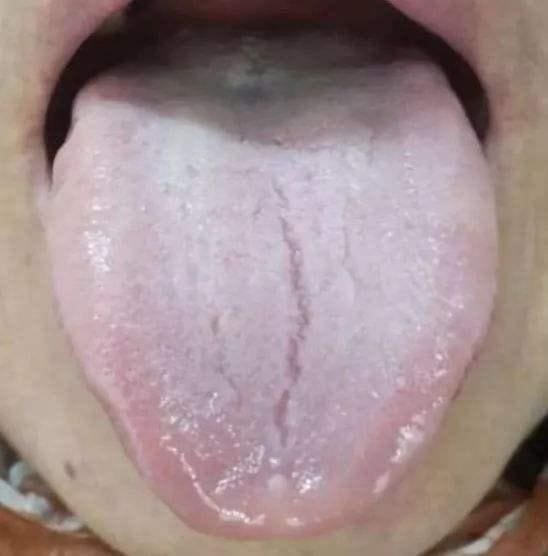
-
Fissured Pale Tongue — Tongue appears plump and tender with fissures and tooth marks
- Description: In cases of qi, blood, or kidney essence deficiency, the tongue cannot be properly nourished, leading to the formation of fissures with an overall pale appearance.
- Tongue Features: A pale tongue showing fissures and often accompanied by tooth marks.
- Associated Pathogenesis: Primarily indicates blood deficiency or kidney essence depletion, often accompanied by symptoms such as a pale complexion, dizziness, and general fatigue.
Conclusion
Through the detailed analysis of various tongue appearances from the perspective of TCM tongue diagnosis, it is evident that:
- The diverse manifestations of the tongue—whether enlarged, thin, aged, delicate, punctate, with tooth marks, smooth, or fissured—offer direct insights into the state of internal qi, blood, body fluids, and organ functions.
- TCM tongue diagnosis is not merely an observational skill but an essential diagnostic method that links the external presentation of the tongue with internal pathological changes. Through careful examination of tongue features, TCM practitioners can accurately differentiate syndromes and enhance clinical treatment outcomes.
- Emphasizing TCM tongue diagnosis not only improves clinical diagnostic precision but also provides a unique perspective for further research in modern medicine.
In summary, mastering the essence of TCM tongue diagnosis is vital for understanding internal pathological changes and developing personalized treatment plans. As an integral part of TCM’s holistic approach, tongue diagnosis continues to gain attention and research interest due to its significant theoretical and practical value.
—————————————————————————————————————————————————————
More Articles in “Identification Tongue”:
- Tongue Sensation & Taste
- Tongue Shape
- Tongue Color
- Tongue Condition
- Tongue Coating
—————————————————————————————————————————————————————

